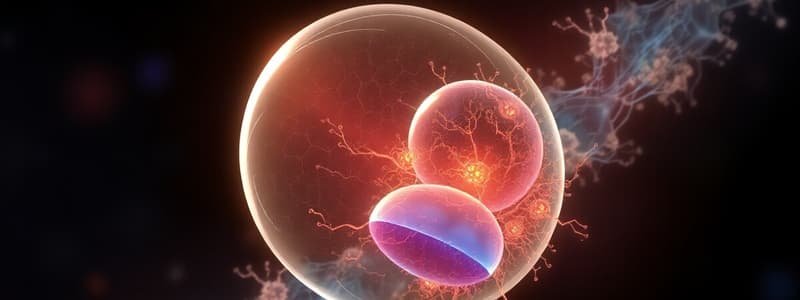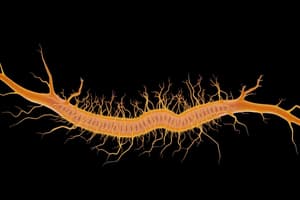Podcast
Questions and Answers
What do the pharyngeal arches contribute to in embryonic development?
What do the pharyngeal arches contribute to in embryonic development?
- Formation of the gastrointestinal tract
- Formation of the lungs and heart
- Building blocks of the structures of the face and oral cavity (correct)
- Development of the circulatory system
Which components are associated with each pharyngeal arch during development?
Which components are associated with each pharyngeal arch during development?
- Nerve supply, blood supply, and cartilage (correct)
- Only nerve supply
- Bone and stomach lining
- Cartilage and muscle only
What is the stomodeum known as in early embryogenesis?
What is the stomodeum known as in early embryogenesis?
- Primitive gut
- First pharyngeal arch
- Embryonic cavity
- Primitive mouth (correct)
The rupture of the bucco-pharyngeal membrane during early embryogenesis allows communication between which two areas?
The rupture of the bucco-pharyngeal membrane during early embryogenesis allows communication between which two areas?
What type of tissues do ectomesenchyme contribute to during embryonic development?
What type of tissues do ectomesenchyme contribute to during embryonic development?
What is the primary focus of the embryology sessions outlined in the module?
What is the primary focus of the embryology sessions outlined in the module?
Which assessment method is categorized as formative in the Embryology module?
Which assessment method is categorized as formative in the Embryology module?
What outcome is associated with interruptions in the embryonic development process?
What outcome is associated with interruptions in the embryonic development process?
Which of the following best defines oral embryology?
Which of the following best defines oral embryology?
What key phase must students be able to outline by the end of the embryology sessions?
What key phase must students be able to outline by the end of the embryology sessions?
What is the primary function of the ectoderm layer in embryonic development?
What is the primary function of the ectoderm layer in embryonic development?
Which layer of the embryonic disc is primarily involved in forming muscles and connective tissues?
Which layer of the embryonic disc is primarily involved in forming muscles and connective tissues?
What is the significance of the neural crest cells during embryo development?
What is the significance of the neural crest cells during embryo development?
What happens during weeks 3-4 of embryogenesis that can affect neurodevelopment?
What happens during weeks 3-4 of embryogenesis that can affect neurodevelopment?
Which of the following accurately describes the progression of the embryonic disc?
Which of the following accurately describes the progression of the embryonic disc?
The primary role of the endoderm in embryonic development is to form:
The primary role of the endoderm in embryonic development is to form:
Which structure originates from the neuroectoderm during embryonic development?
Which structure originates from the neuroectoderm during embryonic development?
What is formed when ectodermal cells differentiate into neuroectoderm?
What is formed when ectodermal cells differentiate into neuroectoderm?
Which cranial nerve is associated with the 2nd pharyngeal arch?
Which cranial nerve is associated with the 2nd pharyngeal arch?
What is a derivative formed from the 1st pharyngeal arch?
What is a derivative formed from the 1st pharyngeal arch?
During which weeks does the development of the head, face, and oral cavity primarily occur?
During which weeks does the development of the head, face, and oral cavity primarily occur?
Which structure supports swallowing and is derived from the 3rd pharyngeal arch?
Which structure supports swallowing and is derived from the 3rd pharyngeal arch?
Which part of the palate forms at the same time as the face?
Which part of the palate forms at the same time as the face?
What is the primary function of the muscles derived from the 4th pharyngeal arch?
What is the primary function of the muscles derived from the 4th pharyngeal arch?
What important structure is derived from the 1st pharyngeal arch cartilage?
What important structure is derived from the 1st pharyngeal arch cartilage?
Which parts fuse to form the primary palate?
Which parts fuse to form the primary palate?
What is one of the key functions of the neural and alveolar portion of the jaw?
What is one of the key functions of the neural and alveolar portion of the jaw?
At what age do the cranial vault bones fully fuse?
At what age do the cranial vault bones fully fuse?
Which section of skull development is responsible for the formation of facial bones?
Which section of skull development is responsible for the formation of facial bones?
What does the fetal development phase mainly focus on after the first 8 weeks?
What does the fetal development phase mainly focus on after the first 8 weeks?
What are the two primary cell types from which skull bones derive?
What are the two primary cell types from which skull bones derive?
What is a potential consequence of interruptions in embryogenesis?
What is a potential consequence of interruptions in embryogenesis?
What is an example of an anomaly related to tongue development?
What is an example of an anomaly related to tongue development?
Which part of skull development does not require full fusion until after brain growth?
Which part of skull development does not require full fusion until after brain growth?
Flashcards
Ectoderm
Ectoderm
Outer germ layer; forms skin, hair, nails, enamel, and neural tissue.
Endoderm
Endoderm
Inner germ layer; forms specialized organs e.g., liver, respiratory, and digestive systems.
Mesoderm
Mesoderm
Middle germ layer; forms muscles, blood, bone, and connective tissues.
Neural Crest Cells
Neural Crest Cells
Signup and view all the flashcards
Stomodeum
Stomodeum
Signup and view all the flashcards
Bucco-pharyngeal membrane
Bucco-pharyngeal membrane
Signup and view all the flashcards
Primitive Gut
Primitive Gut
Signup and view all the flashcards
Pharyngeal Arches
Pharyngeal Arches
Signup and view all the flashcards
Primary Palate
Primary Palate
Signup and view all the flashcards
Neural and Alveolar Portions
Neural and Alveolar Portions
Signup and view all the flashcards
Cranial Vault
Cranial Vault
Signup and view all the flashcards
Fetal Development
Fetal Development
Signup and view all the flashcards
Study Notes
Early Embryonic Development
- Three germ layers form during embryonic development:
- Ectoderm (outer) forms skin, hair, nails, enamel, and neural tissue
- Endoderm (inner) forms specialized organs like liver, respiratory, and digestive systems
- Mesoderm (middle) forms muscles, blood, bone, and connective tissues
- The three germ layers are responsible for forming all tissues and organs in the body
- Interruptions during weeks 3-4 can have significant impacts on neurodevelopment
Neural Crest Cells
- Neural crest cells are formed from the neuroectoderm layer and are crucial for the development of the head, face, and oral cavity
- They migrate throughout the embryo and differentiate into various cell types, including:
- Cranial and sensory ganglia
- Peripheral nervous system
- Connective tissue in the head, face, and oral cavity
- Dentin, pulp, and cementum (but not enamel)
- Stem cells
Week 4 Embryonic Development
- The embryo begins to take shape with the formation of:
- Stomodeum (primitive mouth): the early mouth
- Bucco-pharyngeal membrane: separates the mouth from the primitive gut
- Primitive gut: the precursor to the digestive tract.
- The bucco-pharyngeal membrane breaks down, allowing communication between the stomodeum and gut.
- Pharyngeal Arches (Branchial Arches) develop as bulges on the embryo.
- Each pharyngeal arch has its own nerve supply, blood supply, and cartilage, which contribute to the formation of facial and oral cavity structures.
Development of the Head, Face, and Oral Cavity (Weeks 5-8)
- The face develops from the fusion of five facial prominences:
- One frontonasal prominence
- Two maxillary prominences
- Two mandibular prominences
Development of the Primary Palate (Weeks 6-7)
- The palate develops in two parts:
- The primary palate forms from the fusion of the frontonasal prominence and medial nasal prominences.
- Each jaw develops:
- Neural and alveolar portions to support teeth during development
- Secondary cartilage to support bone growth throughout life.
Development of the Skull
- The skull develops in three sections:
- Cranial vault (brain case)
- Cranial base
- Facial bones
- Skull bones are derived from neural crest cells and mesoderm.
- The cranial vault bones do not fully fuse until 6-7 years old to allow for brain growth.
Fetal Development (Week 9 - Birth)
- After the first eight weeks of development, the fetal development phase begins, focusing on growth.
- Structures formed during the embryonic phase continue to develop and mature.
Developmental Anomalies and Defects
- Embryogenesis is a complex and delicate process that can be susceptible to disruptions, leading to developmental anomalies.
- These anomalies can impact an individual's health and quality of life.
Studying That Suits You
Use AI to generate personalized quizzes and flashcards to suit your learning preferences.




